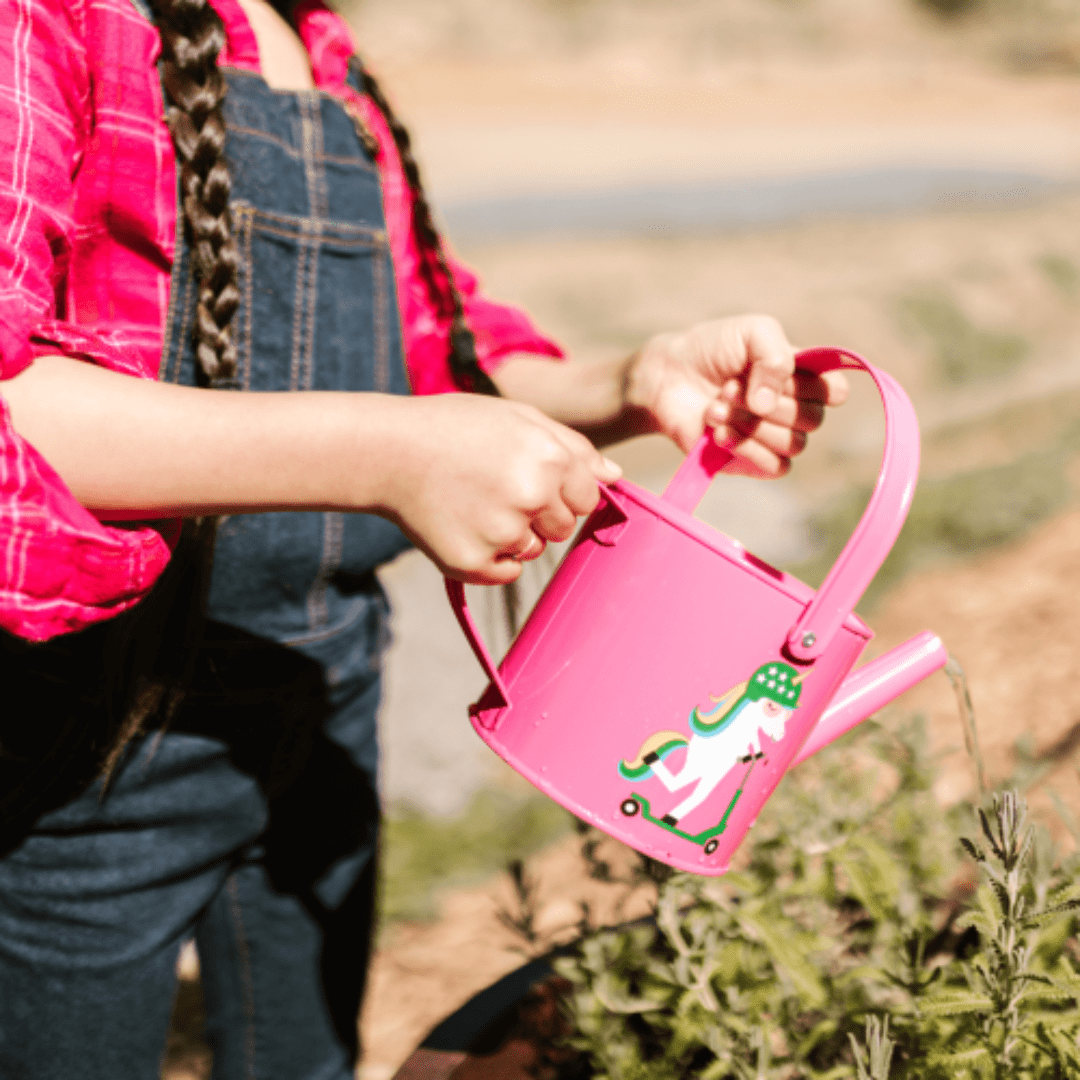Gardening tools for kids.
If you’ve ever had a toddler shadowing your every move, you know how much kids love to help. Whether it’s sweeping the floor, stirring cookie dough, or digging in the dirt, little ones naturally want to be involved in what we’re doing. Gardening is the perfect way to nurture this instinct while also teaching them valuable skills. When kids have their own little tasks—whether it’s planting seeds, watering flowers, or pulling weeds—they feel a sense of accomplishment.
Plus, there’s something magical about watching a tiny seed grow into a flourishing plant, especially when they’ve had a hand in it (or little bare toes!) By giving children real responsibilities in the garden, we’re not just keeping them busy—we’re fostering a lifelong love of nature and self-sufficiency!
This is a pinnable post. Tap or hover over any image in this post to pin to your Pinterest Boards.
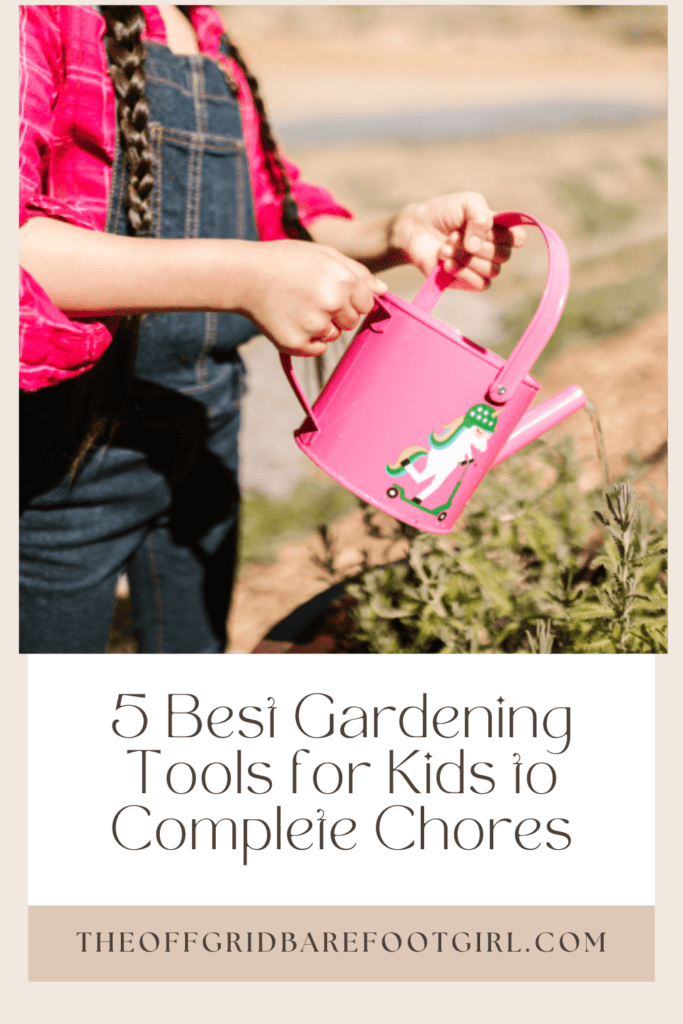
Gardening Teaches Responsibility, Patience, and Life Skills
Gardening is more than just digging and watering—it’s a hands-on lesson in responsibility and patience. When kids plant a seed, they quickly learn that good things take time. They have to water, weed, and wait (sometimes for weeks) before they see any results. That’s a tough lesson in today’s instant-gratification world, but an important one. Gardening also teaches kids how to care for living things, which translates into responsibility in other areas of life.
They begin to understand that plants, like pets or people, rely on consistent care to thrive. And let’s not forget problem-solving—if a plant isn’t growing well, kids have to figure out why. These lessons stick with them far beyond the garden, helping shape their mindset toward responsibility and perseverance.
The Need for Safe, Durable, and Kid-Friendly Tools
Giving kids full-sized gardening tools is a recipe for frustration (and possibly a few stubbed toes). Adult tools are too heavy, too big, and not designed for little hands. That’s why having the right kid-friendly gardening tools makes all the difference. A lightweight watering can prevent spills. A small rake makes leaf clearing fun. Kid-sized gloves protect hands without hindering movement.
Not only do well-made tools make gardening more enjoyable for kids, but they also encourage independence. When kids have their own gear, they’re more likely to take ownership of their chores. Who doesn’t love using their own special tools? Investing in safe, durable equipment designed for children builds their confidence and keeps them engaged in gardening.
1. Kid-Sized Gardening Gloves
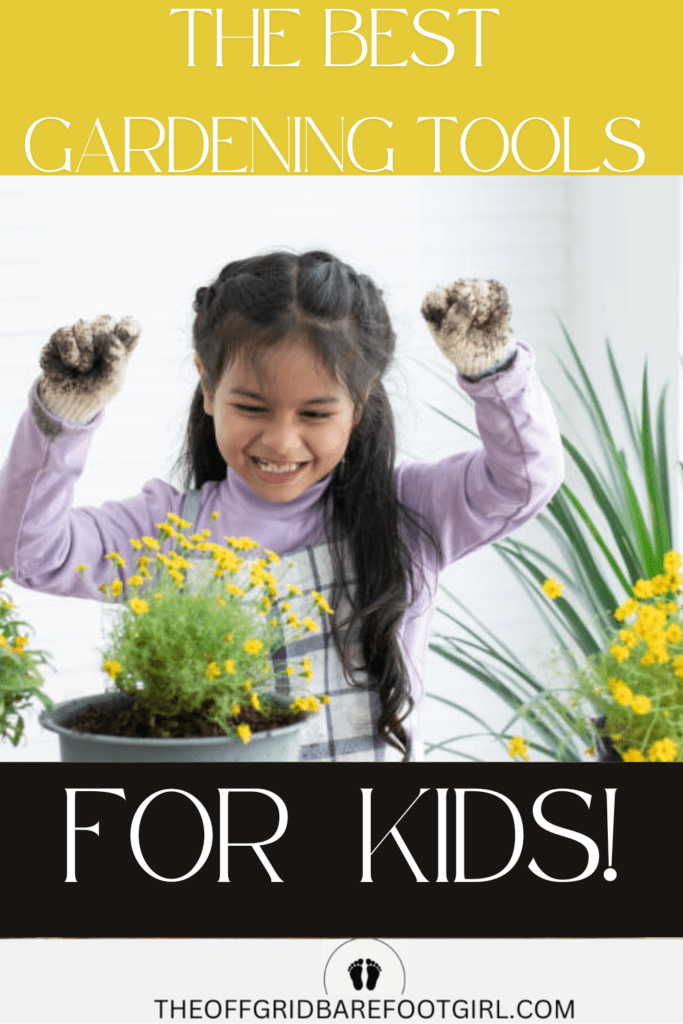
Why Gloves Are Essential for Protecting Little Hands from Dirt, Thorns, and Bugs
Let’s be honest—kids love getting messy. A little dirt under their fingernails is part of the fun, but not everything in the garden is so friendly. Sharp thorns, itchy weeds, and hidden bugs can turn gardening into a chorus of “Ouch!” and “Ew!” That’s why a good pair of gardening gloves is essential. Gloves protect hands from scratches and bug bites, and they help prevent blisters from gripping tools.
Plus, if your kids are like mine, they’ll love having their own special gloves. It makes them feel like real gardeners and encourages them to take their chores more seriously!
Features to Look For: Breathable Material, Snug Fit, Durability
Not all gardening gloves are created equal, especially when it comes to kids. The last thing you want is a pair that’s too stiff, too hot, or too big—because let’s face it, if they’re uncomfortable, your kids won’t wear them. Look for breathable material like cotton or flexible synthetic fabric to keep little hands from getting too sweaty.
A snug fit is also key—gloves that are too loose make it hard to grip tools, while gloves that are too tight won’t last long before they’re abandoned in the dirt. And, of course, durability matters. Kids are rough on everything (including their gardening gear), so opt for gloves with reinforced fingertips and sturdy stitching to withstand all the digging, pulling, and exploring they’ll be doing.
Recommended Garden Gloves for Kids
When it comes to finding the perfect gardening gloves for kids, I’ve tested quite a few (years of teaching gardening to my students and my own kids)—and some just don’t hold up. If you’re looking for great options, here are a few that my kids and I love:
- G & F JustForKids Soft Jersey Gloves – Super soft, lightweight, and perfect for younger kids just starting out.
- Vgo Kids’ Gardening Gloves – These offer a snug but stretchy fit with durable fingertips, great for serious little gardeners.
- HANDLANDY Kids Work Gloves – Designed for tougher chores, these gloves have a grippy palm that helps kids hold onto tools better.
Each of these options keeps little hands safe while still being comfortable enough to wear for longer gardening sessions. If you want your kids to actually keep their gloves on, these are solid picks!
2. Child-Friendly Hand Trowel & Shovel
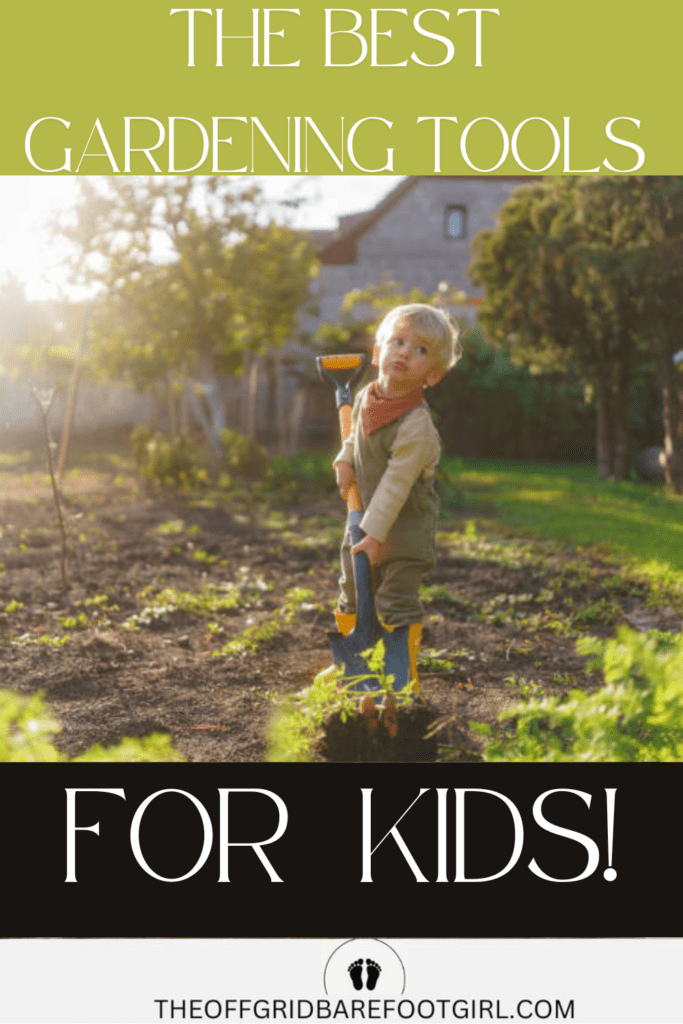
Importance of Having the Right Size Tools for Small Hands
If you’ve ever handed your child a full-sized garden shovel, you know the struggle—too heavy, too awkward, and usually ending in frustration. When kids have tools that fit their hands, everything changes. Suddenly, digging, planting, and scooping becomes fun instead of frustrating.
A properly sized trowel or shovel gives them better control, reduces fatigue, and helps build their confidence in the garden. Plus, when they can use their own tools just like we do, they feel more like real gardeners, which keeps them engaged and excited to help. Choosing the right size means fewer dropped tools, fewer tantrums, and a whole lot more productive garden time!
Material Comparison: Plastic vs. Metal (Pros and Cons)
When shopping for kid-friendly gardening tools, you’ll notice two main materials: plastic and metal. Each has its perks, but knowing the differences can help you choose what’s best for your little gardener.
- Plastic tools are lightweight and safer for very young kids. They’re usually bright and fun but can be flimsy and may snap under pressure (especially in harder soil).
- Metal tools with wooden or rubberized handles are far more durable and work much better for real digging. They’re heavier than plastic, but they give kids a true hands-on gardening experience without breaking after a few uses!
For toddlers just getting started, plastic is fine for light digging in soft soil. But for kids who are ready to really dig, metal tools are the way to go. They’ll last longer and actually help them get the job done!
Top Recommended Kid-Sized Trowels and Shovels
Finding the perfect gardening tools for kids can be hit or miss, but I’ve found some great ones that hold up well and actually work! Here are my top picks:
- JustForKids Metal Hand Trowel – Sturdy, lightweight, and perfect for small hands, this trowel makes digging easy.
- Kids Gardening Tool Set – Comes with a high-quality trowel, rake, and shovel, all with metal heads and wooden handles.
- Kids’ Gardening Shovel – A mini version of an adult shovel, great for kids who love to move dirt!
These tools aren’t just cute—they actually work. They’ll let your kids dig, scoop, and plant right alongside you without frustration.
Fun and Easy Planting Activities Kids Can Do with Their Trowel
Once your little gardener has their own trowel, it’s time to put it to good use!
Mini Sunflower Patch
One of my favorite easy activities is planting a mini sunflower patch—kids love digging little holes, placing the seeds, and watching them grow taller than they are! Sunflowers are super easy to grow!
Grow a Pizza Garden
Another fun one is growing a “pizza garden” by planting tomatoes, basil, and peppers—everything they need to make their own homemade pizza toppings.
Grow a Salad Garden
If they’re impatient (like most kids), fast-growing radishes or lettuce make great starter crops because they sprout quickly.
Burying Treasure
And for an added dose of fun, try burying “treasures” like smooth rocks or golden pirate coins for them to dig up later.
Gardening isn’t just about growing food—it’s about creating memories and hands-on experiences that kids will carry with them for life.
3. Kid-Friendly Watering Can
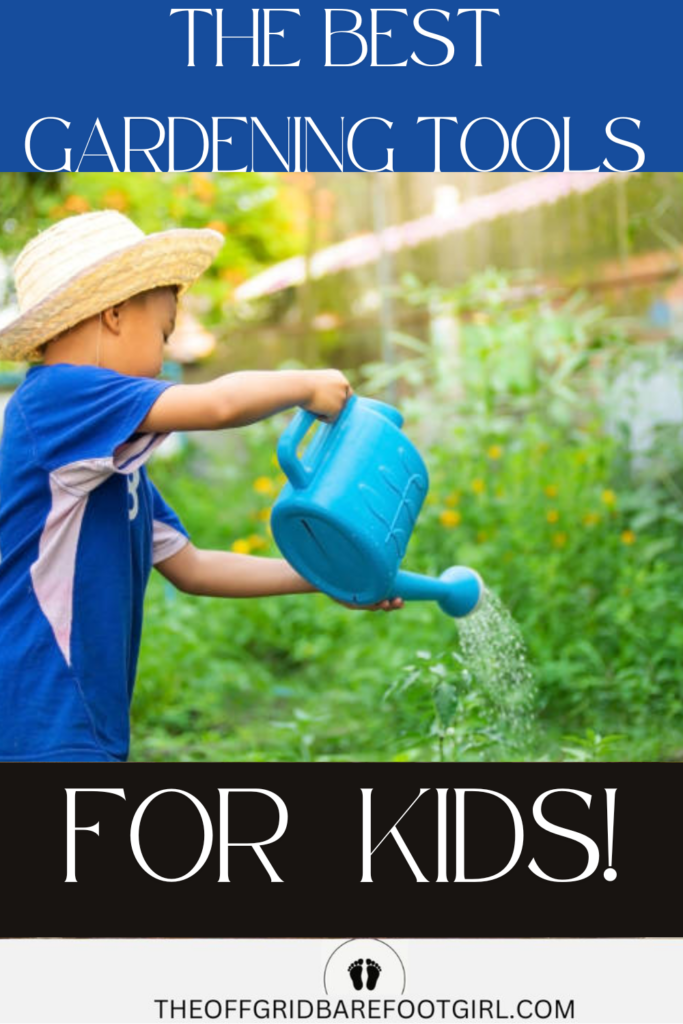
Encouraging Kids to Take Responsibility for Watering Plants
One of the simplest—and most rewarding—ways to get kids involved in gardening is by encouraging them to take responsibility for watering the plants. It’s a task that feels big enough for them to own but small enough to be manageable, and the results are immediate. When they see their plants perk up after a good watering session, it reinforces the idea that their efforts are making a difference.
Plus, it’s a great way to teach kids the importance of consistency in taking care of living things. By making watering a daily ritual, they develop a sense of pride and ownership over their garden, which can carry over to other responsibilities in their lives. And let’s be honest—there’s something magical about watching a child get excited about filling up a watering can and helping their plants thrive!
Features to Look For: Lightweight, Easy-Pour Spout, Fun Designs
When choosing a watering can for kids, it’s essential to think about both functionality and fun. First and foremost, you want something that’s lightweight, so they can carry it without tiring out too quickly. A long, easy-pour spout is a must—this ensures they can water their plants accurately without spilling water everywhere (which also keeps the garden beds neat and tidy!).
The design is just as important for keeping kids engaged. Look for a can with fun, colorful designs or ones shaped like animals or characters—they’ll be more excited to use it if it feels like part of the play! A good watering can should be easy to grip and sturdy enough to withstand a few drops, making it the perfect tool for your budding gardener.
Recommended Watering Cans for Kids
Having the right watering can can make all the difference in getting kids excited to help in the garden. Here are some of my top recommendations:
- Green Toys Watering Can – Made from recycled materials, this one is lightweight, durable, and comes in fun colors like blue and pink—perfect for younger kids!
- Melissa & Doug Sunny Patch Watering Can – This cheerful watering can is designed for little hands, with a great pouring spout and a fun design that encourages kids to keep using it.
- Hape Kids’ Watering Can – It’s eco-friendly and built to last, plus the spout is wide enough for a steady stream without making a mess.
Each of these options is thoughtfully designed to help kids develop good watering habits while adding a touch of fun to their gardening routine.
Engaging Ways to Teach Kids Proper Watering Techniques
Teaching kids the right way to water their plants doesn’t have to be boring—it can actually be a fun and interactive activity! Start by explaining how different plants have different water needs—some like it dry, and others need more moisture. Let them test this by feeling the soil before your kids water. You can also turn watering into a little game: challenge them to water the plants without spilling or encourage them to count how many plants they water each time.
To make it even more educational, teach them the “slow and steady” approach, showing them how to water slowly and gently around the base of the plant to avoid disrupting the soil. And don’t forget to celebrate their efforts—whether it’s a “high five” or a simple “great job,” reinforcing their responsibility helps them feel good about their contribution to the garden!
4. Lightweight Rake for Kids
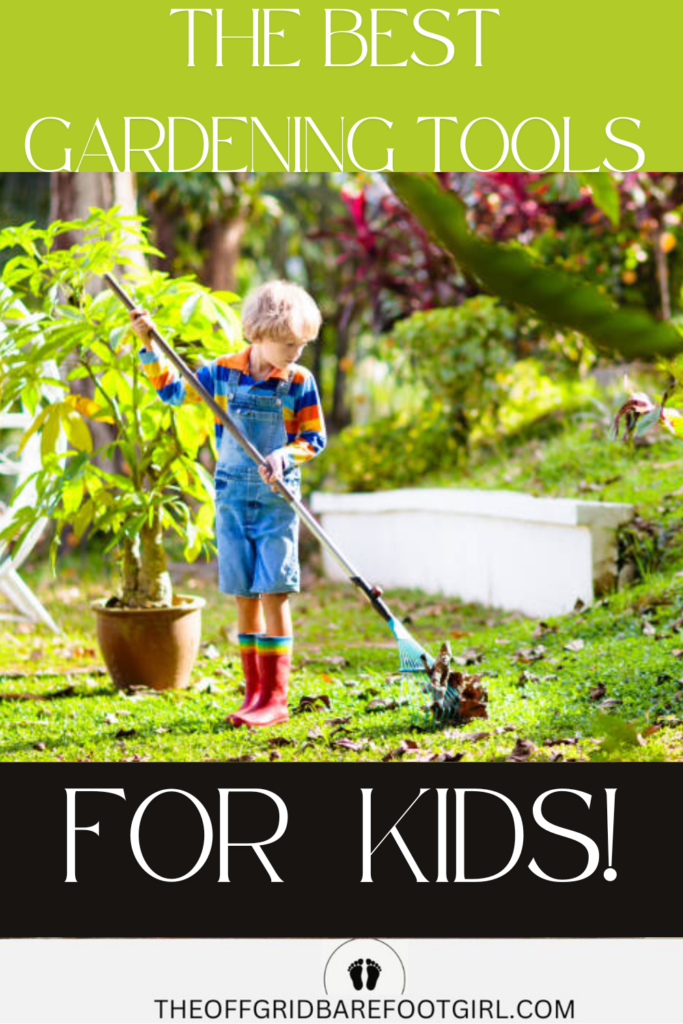
Teaching Kids How to Maintain Garden Beds and Clear Leaves
Maintaining a garden bed and clearing leaves is an essential task that’s perfect for getting kids involved in garden upkeep. It’s more than just a chore—it’s an opportunity to teach kids about the importance of keeping things tidy and healthy in the garden. As I’ve learned over the years, kids love to feel like they’re in charge of a specific task, and raking leaves or fluffing up the soil in garden beds is a great way for them to take ownership of a part of the garden.
Not only does this help plants thrive, but it also teaches kids how to recognize when things need attention. You can even make it a fun family activity by turning the task into a little competition to see who can clear the most leaves, or challenge them to make the neatest, most organized garden bed.
Key Factors: Handle Length, Weight, and Material Durability
When it comes to choosing a rake for kids, you want to make sure it’s the right size for them—after all, a tool that’s too big or too heavy can make the task feel like a struggle. The handle length should be short enough for them to comfortably grip and maneuver, but long enough to reach the garden bed or leaves without straining. Look for a rake that is lightweight to avoid tiring them out too quickly.
Most importantly, the rake should be made of durable materials—preferably steel or sturdy plastic—so it can handle the wear and tear of regular use. Remember, kids are tough on their tools, so choosing one that can stand up to their energy and enthusiasm is key!
Best Kids’ Rakes Available
I’ve tried quite a few kids’ rakes over the years, and these are the top picks that my kids and I keep coming back to for leaf clearing and garden maintenance:
- Little Tikes Garden Tool Set with Rake – This set includes a lightweight rake that’s perfect for younger kids, with a sturdy handle and an easy-to-hold design.
- Gardener’s Supply Company Kids’ Rake – This rake is designed with a smaller head and a comfortable grip, making it easy for kids to handle while still being strong enough to clear leaves efficiently.
- Hape Kids’ Rake – A well-crafted, eco-friendly rake that’s perfect for little hands, offering both durability and comfort for your child as they tackle garden tasks.
These rakes are not only durable, but are also designed specifically to encourage kids to get excited about maintaining their garden space.
Fun Chore Ideas That Make Raking Enjoyable for Kids
Let’s face it—raking leaves isn’t the most exciting task, especially for kids. But that doesn’t mean we can’t make it fun! One of my favorite ways to get kids involved is by turning raking into a game. For example, create a challenge to see who can rake up the most leaves in the shortest amount of time. You can even create leaf piles in different parts of the garden and then have a race to see who can fill the pile the highest with leaves.
For an added twist, encourage them to decorate the leaf pile with colorful sticks, rocks, or small toys as a “leaf art” project. Another fun idea is to use the rake to make patterns in the leaves before they’re bagged up. By adding a playful twist, raking becomes less of a chore and more of a game they’ll actually look forward to.
5. Children’s Wheelbarrow or Garden Cart
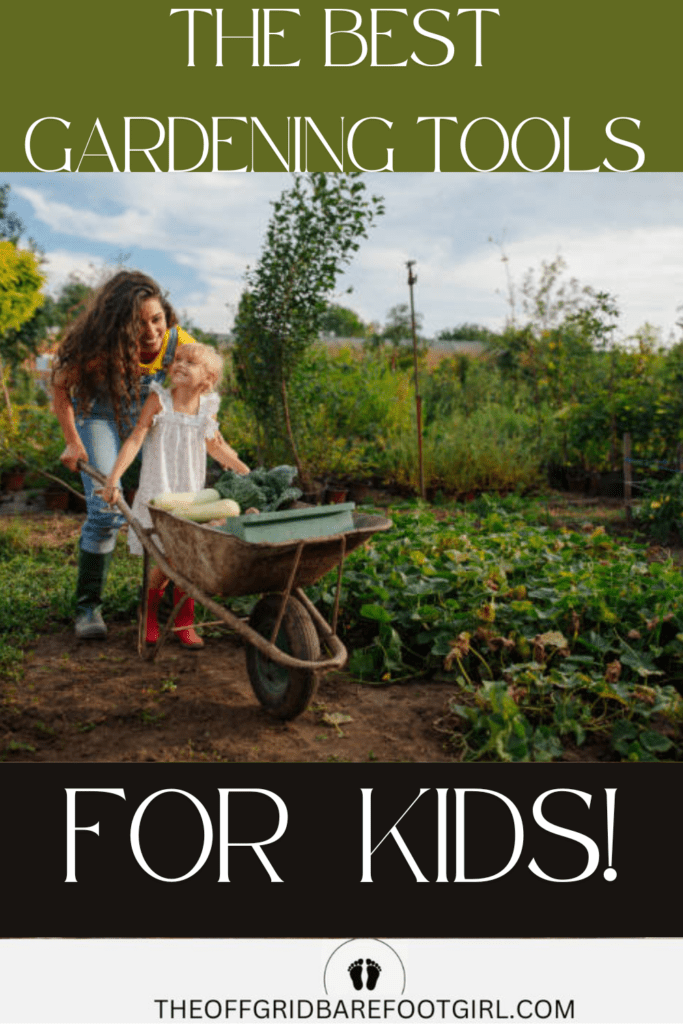
How a Kid-Sized Wheelbarrow Makes Transporting Dirt, Leaves, and Tools Fun
A kid-sized wheelbarrow is one of those gardening tools that turns a regular task into something magical. Imagine how much fun it is for kids to fill up their own little wheelbarrow with soil, leaves, or garden tools and haul it across the yard. I actually love this activity too! It’s the perfect blend of responsibility and play, and they’ll love being able to help with tasks that adults usually take care of.
Whether they’re moving dirt to create a new garden bed, collecting fallen leaves, or simply transporting their tools around, a wheelbarrow makes the job feel like an adventure. It’s also great for building their strength and coordination, not to mention a wonderful way for them to feel like they’re really contributing to the garden. They’ll be so proud of the work they’re doing, and honestly, watching their excitement as they push their own wheelbarrow is one of my favorite things!
Safety Tips for Using a Wheelbarrow
While wheelbarrows are a ton of fun for kids, it’s important to teach them how to use them safely to prevent accidents. Start by emphasizing the importance of keeping the load balanced in the wheelbarrow so it doesn’t tip over. It’s also important to teach them to push, not pull, as this helps maintain control, especially when the wheelbarrow is full.
Always make sure they’re using a wheelbarrow that’s the right size for them—if it’s too big or too heavy, it could cause strain or lead to tipping. I also suggest showing them how to use their body to guide the wheelbarrow, with their hands firmly on the handles and their feet positioned in a way that avoids tripping.
And most importantly, never let them run with a full wheelbarrow, as that’s when the risk of tipping increases. Teaching these basic safety tips ensures they can enjoy using their wheelbarrow without injury!
Recommended Sturdy and Lightweight Wheelbarrows
Choosing a sturdy yet lightweight wheelbarrow for kids is key to making sure they can handle it without getting overwhelmed. Here are a few I highly recommend:
- Step2 Kids’ Garden Wheelbarrow – This bright and fun wheelbarrow is perfect for younger gardeners. It’s lightweight, easy to maneuver, and made from durable plastic, which means it won’t rust or corrode like metal.
- HearthSong Garden Wheelbarrow – Another great option, this wheelbarrow has a strong wooden frame and rubber wheels, making it both sturdy and easy to push. It’s a little more traditional, with a classic design that kids will love.
- Gorilla Cart Kids’ Wheelbarrow – If you’re looking for something a bit more robust, the Gorilla Cart is perfect. It features a sturdy steel frame and large wheels that make it easy to maneuver over rough terrain while still being lightweight enough for kids to push around.
These wheelbarrows are built to last and designed for kids to enjoy—whether they’re helping in the garden or just playing outside!
Creative Ways to Involve Kids in Moving Materials Around the Garden
The wheelbarrow can be more than just a tool—it’s a gateway to creativity and fun in the garden. For example, have your kids designate a “garden delivery route”, where they move different materials to various spots around the garden. You can also create a fun “gardener’s relay race” where they have to transport items as quickly as possible without spilling them.
For a more educational twist, encourage your kids to sort the materials—maybe they’re moving dirt to one side of the garden and leaves to another, or organizing their tools in different areas. You can also make a fun “garden treasure hunt,” where they search for certain items to move around the yard or garden. With a kid-sized wheelbarrow, there’s no end to the creative ways they can get involved in the work and have fun while doing it!
Conclusion
Recap of the 5 Must-Have Gardening Tools for Kids
In today’s post, we’ve explored the 5 must-have gardening tools for kids that will not only make gardening easier, but also way more fun. These tools—gloves, kid-sized trowels and shovels, watering cans, rakes, and wheelbarrows—are specifically designed to fit small hands and ensure that kids can safely and comfortably contribute to garden tasks.
Gloves protect little hands from dirt, thorns, and bugs, while the trowels and shovels help kids dig and plant with ease. Watering cans make it easy for them to care for their plants, and sturdy rakes allow them to maintain the garden and clear leaves. Of course, a lightweight wheelbarrow adds a fun element of transportation, making every chore an adventure!
How Involving Children in Gardening Benefits Both Them and the Garden
Getting kids involved in gardening has endless benefits—not only for them but for the garden itself! As they plant seeds, pull weeds, or water the plants, they’re learning responsibility, patience, and basic life skills. They also develop a stronger connection with nature and a sense of accomplishment as they see their hard work pay off. For the garden, their efforts help with the upkeep and growth of plants, keeping the space healthy and thriving. It’s a win-win!
Plus, involving kids in gardening encourages them to appreciate where food comes from, fostering a sense of self-sufficiency. It’s truly one of the best ways to teach kids the value of hard work and nature, while also providing them with the hands-on experience of nurturing something from the ground up.
Invest in Quality Tools for a Fun and Educational Experience
When it comes to getting kids involved in gardening, the right tools make all the difference. Investing in quality tools that are both safe and durable helps create a positive, rewarding gardening experience for kids. Not only will these tools last, but they’ll also be designed with the perfect size and weight to ensure that gardening is accessible and enjoyable for children.
Trust me, having the right gear encourages kids to stay engaged and excited about their tasks, making the whole process more fun and educational. Gardening is such an enriching activity, and by providing the right tools, parents can create lasting memories and teach valuable skills along the way.
Check Out the Recommended Products to Get Your Kids Started in the Garden Today!
Ready to get your kids started on their gardening journey? Check out the recommended tools I’ve shared throughout the post! Whether you’re looking for gloves to protect little hands or a sturdy wheelbarrow for hauling materials, these tools will help your kids get started in gardening with excitement.
Believe me, they’ll love the chance to be involved in creating and maintaining your garden, and you’ll love seeing their confidence grow. Don’t wait—grab the perfect gardening tools today and let the fun and learning begin!
Resources: Here are some helpful resources for further information.
- 17 Outside Chore Ideas for Kids – By GoHenry
- Garden Chores for Kids By Age Range – By Homestead Lady
- Age-Appropriate Garden Activities – By Redwood Barn Nursery
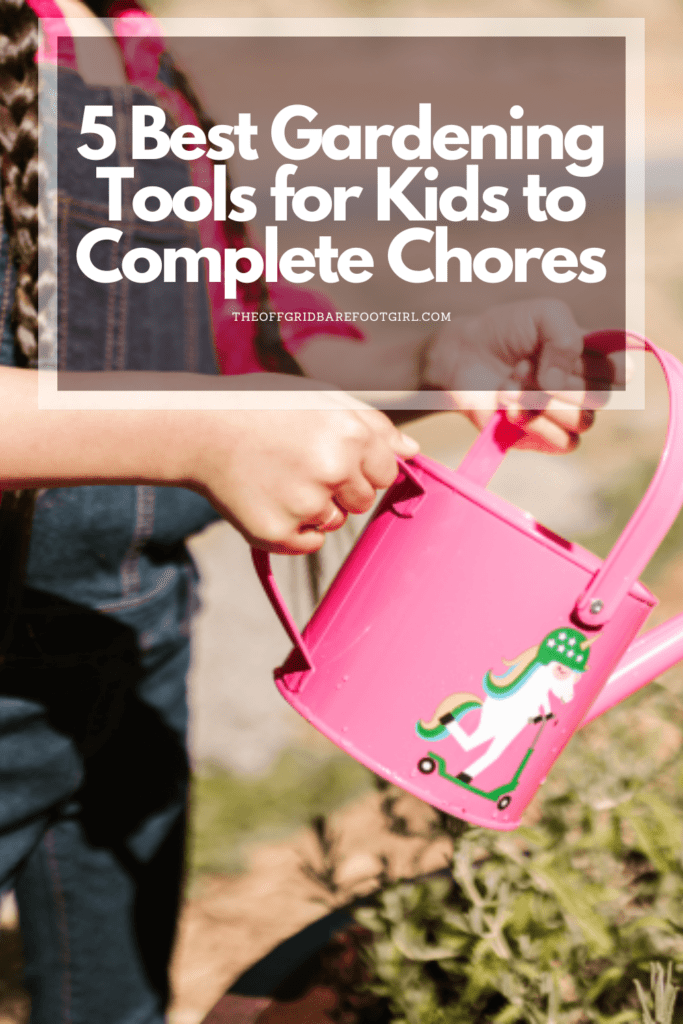
Frequently Asked Questions
1. What age is appropriate for kids to start using gardening tools?
Kids as young as 3-4 years old can begin using gardening tools with proper supervision. Age-appropriate tools, like lightweight trowels and watering cans, help them build confidence and develop fine motor skills.
2. Are these tools safe for my child?
Yes, the gardening tools recommended for kids are specifically designed with safety in mind. They have rounded edges, lightweight materials, and kid-friendly features to minimize risk while still allowing for hands-on learning.
3. How do I encourage my child to help in the garden?
Make gardening fun and interactive by giving them small, manageable tasks. Use creative activities like a garden scavenger hunt or watering challenge to keep them engaged while teaching responsibility.
4. Can gardening help my child develop life skills?
Absolutely! Gardening teaches kids patience, responsibility, and teamwork. It’s a great way to help them learn about nature, time management, and the satisfaction of growing something from scratch.
Summary
I hope I have inspired you to do gardening with your kids with these tips and products.
If you were encouraged by this post, I invite you to check out my FREE Printables Page for fun free printables, planners, and charts.
ENTER MY FREE Printables Page HERE
Here are some more of my inspiration posts to check out!
Homesteading: How to Do Homesteading with Kids
Preparation: How to Create the Ultimate Bugout Bag for Kids
How To Plan An Exciting Easter Egg Hunt In Your Spring Garden!
DIY Pop-Tart Gingerbread Houses: The Ultimate Holiday Activity for Kids
How to Have a Safe and Exciting Mountain Sledding Experience with Teens!
A-maze-ing Fun In a Corn Maze with Teens
17 Free Outdoor Summer Boredom Busters for Kids
Lake Fishing with Kids: What to Know Before You Go
Ultimate Guide on River Safety for Kids
Why Archery for Kids Teaches a Growth Mindset
Homeschooling Teens With Anxiety: How Easy It Can Improve Grades
5 Best Gardening Tools for Kids to Complete Chores
How to Open A Can of Food With Your Bare Hands
The Best Activities for First Aid for Kids
Knife Safety for Kids: Ultimate Guide to Their Safety
Blessings,
The Off Grid Barefoot Girl

